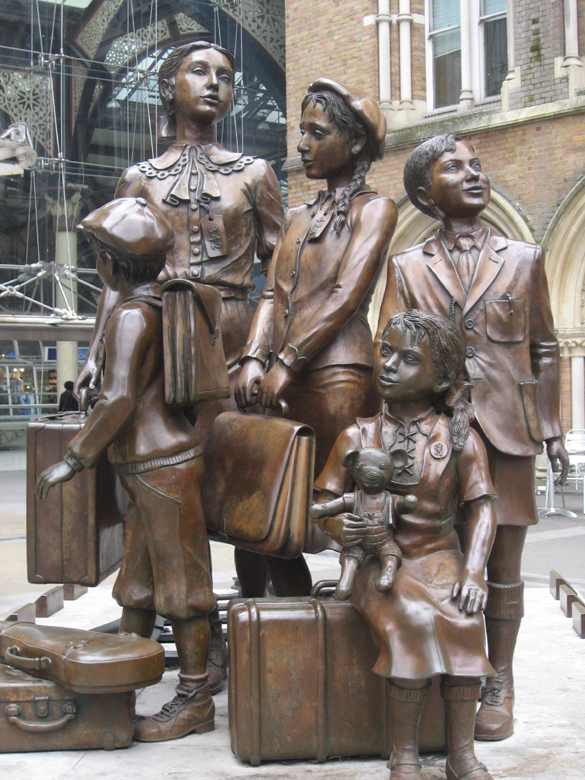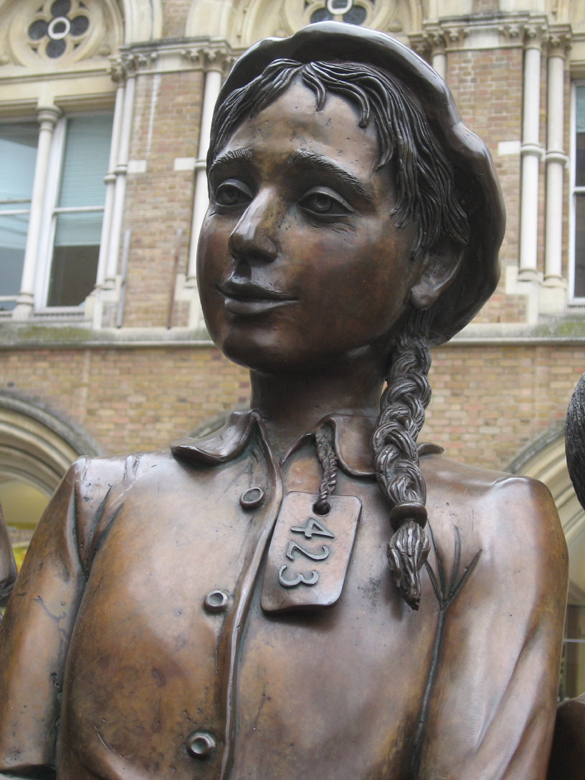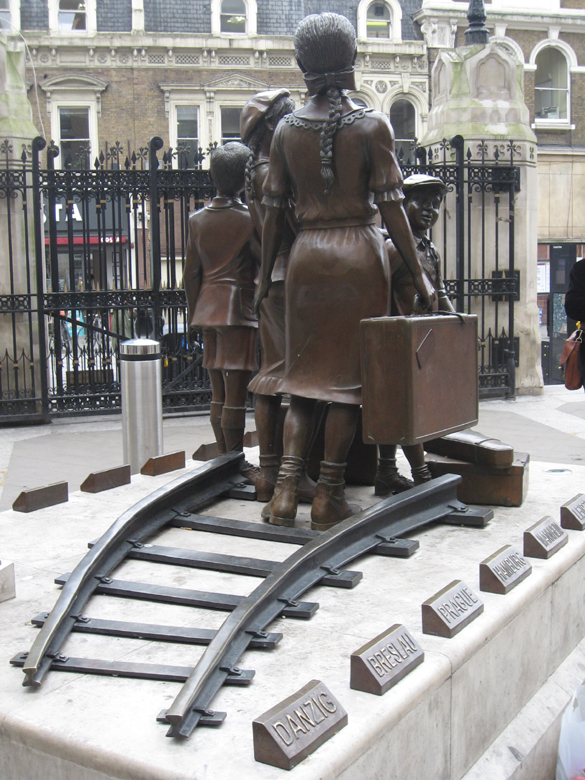I arrive at Liverpool Street Station in London amid determined commuters and disorientated tourists. Something catches my eye as I head up the stairs past McDonald’s. I find myself in front of a modern statue in bright bronze of a collection of five children. They are standing still and looking around. They don’t seem lost. Their features remind me of Jewish friends I have worked with.
This is about the Kindertransport. In 1938 and 1939, ten thousand unaccompanied Jewish children were transported to Britain to escape persecution in their hometowns in Germany and Austria. These children arrived at Liverpool Street station to be taken in by British families and foster homes. Only a few were reunited with their families after World War II.
This 2006 commemorative statue is the work of Frank Meisler and Arie Oviada. It is beautiful, precise and poignant. The children are poised and proud. Their heads are held high. They are determined. They are looking to the future. They do not carry themselves as victims. Their faces radiate hope. A greater innocence is underscored by the youngest girl clutching a teddy bear. The young boy maybe brings musical talent with him; he has a violin case by his side. The tallest girl’s pubescence has been captured to perfection.
However, each child has a tag with a number. Behind the group is a short section of railway line. Both tags and rails serve as disconcerting reminders of what might have been had they not been brought to Britain. Numbers might have been tattooed on their arms and railways might have brought them to Auschwitz or Belsen rather than to Liverpool Street.
Talking Beautiful Stuff is about the narrative behind any output of the human impulse to create; this beautiful stuff has narrative by the ton. Once again, I am struck by how really, really ugly stuff can be the source of inspiration for really, really beautiful stuff.
And if this was not testament enough to the human folly and cruelty of the 20th century, twenty metres away is the marbled roll of honour with the names of 900 (yes, 900!) employees of the Great Eastern Railway who lost their lives in the Great War of 1914 to 1918. I realise that, had they survived, they might have witnessed the Kindertransport. I feel tears in my eyes and head for the bustling sanctuary of the London Underground.
The Kindertransport commemorative statue was sponsored by the Association of Jewish Refugees and the Central British Fund for World Jewish Relief.




Thank G-d for memories…It was a good/hideous moment in time.
I live in America and know many of these people…It is marvelous!!!!!!!!
Heartwarming
The whole world should never forget.
They may not seem like they carry themselves as victims, however they were, in fact, victims of a terrible atrocity. I know about this firsthand as I carry the name of one of these children. Her name was Deborah Gabriel. She was sent out of Germany as a teenager on the Kindertransport, and lived with a family in London for the duration of the war. Her entire family was murdered. After the war she left London alone as a young adult, and traveled to the United States. My parents sponsored her. I was born just about the time she arrived in New York and was given a middle name in her honor. She lived the rest of her life alone in Manhattan and is by now deceased.
Joan,
Thank you for your very touching comment. The interest in this article has been fantastic. Go well.
Robin
Hugo meisler, as far as I know, was one of these children.
Being fighter-pilot in Israel Air Force he served in Israel-london-ambassy some 60 years ago.
is he family with Frank?
[He was one of three Israeli trained pilots – that I knew – from the “kindertransport”]
I used to commute through Liverpool Street Station until the Early 1980s. There was nothing about the Kindertransport. It was only recently that I came across the 2 memorials, which ignited my curiosity. This was something that was never mentioned in history lessons at school (in the 1970s) Now I want to visit all the memorials and find out more about this fascinating period of history.
my grandmother was sent to England as part of the kinderstransport, she believed for many many years her entire family had perished in auschwitz. By some entire fluke years later (long story short) she discovered a brother and her father had survived, by the time she tracked them down her father had only passed away 3 years previously, her mother, sisters and other brother had indeed perished in the concentration camps.
She had lived all those years be living she was an orphan, the English family she was placed with, had changed her name and formally adopted her, no one knows if any attempt was made by her family to find her after the war. I guess records were lost, or changed who knows?
She never really recovered, and had nightmares of the ghettos
Thank you for your comment. What a sad story! I am so sorry.
Robin
The data you present should be adjusted to more accurately show the numbers of children who were saved. According to his book: “Kinder Transporte–A Study of Stresses and Traumas of Refugee Children” Rabbi Jacob Newman, M.A. D.Litt. states that the number of Jewish children were 7,486 . Presumably the remaining 2,500 (to make up the total 10,000) were non-Jewish, whose parents were regarded as undesirables by the Nazis and who escaped at the same time and by the same means.
This book has recently came to light in Israel, having been made available from an unsold collection of about 150 kept by the son of its (deceased) author. For a copy write to ESRA book store, Beit Fisher, 5 Klausner Street, Ra’anna, Israel. There is also a website run by this organization.
Dear David,
I am writing a dissertation about Kindertransport children in Shropshire. I came along Jacob Newman’s research, but unfortunately cannot find anything about him, like academic career. The Preface mentions him as Professor and Rabbi. Have you got more information. If so I would be very grateful, if you share them.
Thank you very much and all the best wishes
Axel Wittenberg
Why no reference to Sir Nicholas Winton, almost solely responsible for this?
Fantastic statues. Probably no mention sir Nicholas Winton because he did not want publicity.
maybe something UK specific would have been more suitable. How about a slave trade memorial.
I wrote a story about this operation and did much research. Sir Nicholas Winton was the sole instigator of this rescue, and the correct number of children saved was 669, between March and August 1939. The last train load of two hundred and fifty children were aboard ready to start their journey on 3rd September, but Germany invaded Czechoslovakia and Britain declared war on Germany so all the borders were immediately shut. Within an hour the train was diverted to a German camp site, and the children were never heard of again. For fifty years no-one knew any details even the children themselves until Sir Nicholas showed a friend all the identity cards from the children and the friend passed the information it on to the BBC. The rest is history. Sir Nicholas lived to be 105 years of age and died only last year. Most children rescued lost their entire families. Yes, it should never be forgotten.
Shame the May government is leaving children to die instead of following the moral example this statue represents.
Kristi – CITATION NEEDED.
The young boy, I believe, was Sir Erich Reich.
I’m a part of polish crew taking part in a short historical movie competition. We need a lot of photos connected to Kindertransports. May I use the ones from this page?
Yes, please do. Would be great if you can add a link back to our site. Best, Isaac
I saw the same children running fvrom the zionists in 1948 with their little suitcases..we need a statue to them..hundreds and hundreds far more than the kindertransport kids
Let us not forget that the Daily Hate Mail ( Yes, the same newspaper that is now running a ahte campaign against immigration & for Brexit …)
Campaigned against Albert EInstein being allowed into Britain
My mother – Lili Pollard (nee Weissman) was one of the KinderTransport children. She left Vienna (Wien West Hauptbahnhof) at the beginning of August 1939, travelling via Hook of Holland and Harwich, and arriving at Liverpool Street Station. She always regretted not nagging her parents more, so that Heinz, aged 7, could join her. She came here aged 15, and became a Land Girl for 2 years, working in glasshouses in Hampshire. Then for 4 years, she provided coloured drawings of fashions for the Berkertex womens’ fashion house. Although she did a number of different jobs in the 1950s – 70s, in her spare time she became a one-person art factory, and I still have some of her productions of figures , flowers and butterflies. At 90, she became a Hebrew Christian (like myself). She died on 23 January 2022, almost reaching 98.
Thank you for telling us about your mother. A fantastic woman! Best wishes, Robin
I have been sharing this wonderful statue with my Y9 students this week as they learn about the Holocaust. I shall look out for the statue when i next travel through Liverpool St.
Could it be that the Seekers’ 1965 hit “Morningtown Ride” was inspired by the story of the Kindertransporte?
Very unlikely – it was written in 1957 by Malvina Reynolds, an American, and recorded in 1966 by The Seekers and is actually a lullaby. She also wrote “Little Boxes” and “What have they done to the Rain?” Lovely thought though!
As far as I know, the original Kindertransports were for children from Germany and Austria and took place in 1938 and 1939.
Then, in 1939, British Sir Nicholas Winton organized trains for 669 children from Czechoslovakia, as well as foster parents in the U.K., for these children. He had helpers (including his mother) in London and in Prague. His heroism only became known in 1988 through the BBC programme This is your Life. He died, in 2005, at the age of 106. One Life, a movie about Sir Nicholas, will be released in 2024. I am one of the 669. Jane.
Jane. Thank you so much for your comment. We greatly appreciate you sharing the additional history on this story. With our very best wishes, Robin and Isaac
A memory of my dear friend Josie Cohen, who she sad came over with the transport You are missed x
SInce 2022 there has been a statue group of 5 Kindertransport arrivals close to the pier in Harwich, where around 2000 children first set foot in Britain. Liverpool Street is the London terminus for trains to and from Harwich.
The Harwich memorial is called “Safe Haven” and is the work of Essex-based artist, Ian Wolter. Here’s a couple of weblinks:
https://kindertransport-memorial.org/
https://www.ukholocaustmap.org.uk/map/records/b1e986ec-0ab6-4666-bec4-bf2b1ade737f